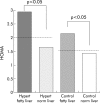Increased prevalence of fatty liver in arterial hypertensive patients with normal liver enzymes: role of insulin resistance
- PMID: 15194655
- PMCID: PMC1774102
- DOI: 10.1136/gut.2003.027086
Increased prevalence of fatty liver in arterial hypertensive patients with normal liver enzymes: role of insulin resistance
Abstract
Background: The conditions associated with fatty liver disease presenting with normal liver enzymes and the mechanism involved in its development remain to be fully elucidated.
Aims: The aim of the present study was to test the hypothesis that fatty liver with normal liver enzymes occurs more frequently in arterial hypertensive patients and to establish whether this condition is associated with insulin resistance.
Patients: A total of 55 non-obese, non-diabetic, non-heavy alcohol drinking patients with arterial hypertensive and normal liver enzymes and 55 sex and age matched healthy subjects were enrolled into the study.
Methods: Plasma metabolic parameters, body mass index, and the presence of fatty liver were investigated. Insulin resistance was estimated from plasma insulin and glucose as the homeostasis model assessment index. Stepwise logistic regression and multivariate regression analysis were used on the combined sample to identify variables independently associated with fatty liver and insulin resistance.
Results: Hypertensive patients had a significantly higher prevalence of fatty liver (30.9% v 12.7%; p<0.041), higher insulin resistance (mean 2.27 (SD 1.81) v 1.56 (0.70); p = 0.022), and slightly higher body mass index (24.9 (3.0) v 24.0 (2.2); p = 0.043) than controls. Multivariate logistic regression identified insulin resistance (odds ratio 1.66 (95% confidence interval (CI) 1.03-2.52)) and body mass index (OR 1.22 (95% CI 1.00-1.49)) as factors independently associated with fatty liver. Multivariate regression analysis showed insulin resistance to be predicted by alanine transaminase (p = 0.002), presence of arterial hypertension (p = 0.029), and body mass index (p = 0.048).
Conclusion: The higher prevalence of non-alcoholic fatty liver in non-obese hypertensive patients with normal liver enzymes appears to be related to increases in insulin resistance and body weight.
Figures

Comment in
-
Fatty liver, hypertension, and the metabolic syndrome.Gut. 2004 Jul;53(7):923-4. doi: 10.1136/gut.2003.037309. Gut. 2004. PMID: 15194635 Free PMC article.
Similar articles
-
The relationship between insulin resistance, metabolic syndrome and nonalcoholic fatty liver disease in non-obese non-diabetic Turkish individuals: A pilot study.Turk J Gastroenterol. 2014 Dec;25 Suppl 1:63-8. doi: 10.5152/tjg.2014.6233. Turk J Gastroenterol. 2014. PMID: 25910371
-
Serum retinol-binding protein 4 is independently associated with pediatric NAFLD and fasting triglyceride level.J Pediatr Gastroenterol Nutr. 2013 Feb;56(2):145-50. doi: 10.1097/MPG.0b013e3182722aee. J Pediatr Gastroenterol Nutr. 2013. PMID: 22983378
-
Nonalcoholic fatty liver disease is associated with blood pressure in hypertensive and nonhypertensive individuals from the general population with normal levels of alanine aminotransferase.Eur J Gastroenterol Hepatol. 2011 Nov;23(11):1011-7. doi: 10.1097/MEG.0b013e32834b8d52. Eur J Gastroenterol Hepatol. 2011. PMID: 21915061
-
Ambulatory arterial stiffness indices and non-alcoholic fatty liver disease in essential hypertension.Nutr Metab Cardiovasc Dis. 2013 Apr;23(4):389-93. doi: 10.1016/j.numecd.2012.05.007. Epub 2012 Jul 15. Nutr Metab Cardiovasc Dis. 2013. PMID: 22796347
-
Risk of severe liver disease in nonalcoholic fatty liver disease with normal aminotransferase levels: a role for insulin resistance and diabetes.Hepatology. 2008 Sep;48(3):792-8. doi: 10.1002/hep.22429. Hepatology. 2008. PMID: 18752331
Cited by
-
Hyperinsulinemia predisposes to NAFLD.Indian J Clin Biochem. 2008 Apr;23(2):130-5. doi: 10.1007/s12291-008-0030-6. Epub 2008 Jun 11. Indian J Clin Biochem. 2008. PMID: 23105738 Free PMC article.
-
Liver circadian clock disruption alters perivascular adipose tissue gene expression and aortic function in mice.Am J Physiol Regul Integr Comp Physiol. 2021 Jun 1;320(6):R960-R971. doi: 10.1152/ajpregu.00128.2020. Epub 2021 Apr 21. Am J Physiol Regul Integr Comp Physiol. 2021. PMID: 33881363 Free PMC article.
-
Increased levels of systolic blood pressure within the normal range are associated with significantly elevated risks of nonalcoholic fatty liver disease.Medicine (Baltimore). 2015 May;94(19):e842. doi: 10.1097/MD.0000000000000842. Medicine (Baltimore). 2015. PMID: 25984671 Free PMC article.
-
Oxidative stress-mediated mitochondrial dysfunction contributes to angiotensin II-induced nonalcoholic fatty liver disease in transgenic Ren2 rats.Am J Pathol. 2009 Apr;174(4):1329-37. doi: 10.2353/ajpath.2009.080697. Epub 2009 Feb 26. Am J Pathol. 2009. PMID: 19246643 Free PMC article.
-
Establishment of a mouse model of enalapril-induced liver injury and investigation of the pathogenesis.Lab Invest. 2017 Jul;97(7):833-842. doi: 10.1038/labinvest.2017.22. Epub 2017 Mar 6. Lab Invest. 2017. PMID: 28263289
References
-
- Younossi Z , Diehl A, Ong J. Non alcoholic fatty liver disease: an agenda for clinical research. Hepatology 2002;35:746–52. - PubMed
-
- Bellentani S , Saccoccio G, Masutti F, et al. Prevalence of and risk factors for hepatic steatosis in Northern Italy. Ann Intern Med 2000;132:112–17. - PubMed
-
- Falck-Ytter Y , Younossi Z, Marchesini G, et al. Clinical features and natural history of non alcoholic steatosis syndromes. Semin Liver Dis 2001;21:17–26. - PubMed
-
- Teli M , James O, Burt A, et al. The natural history of nonalcoholic fatty liver: a follow-up study. Hepatology 1995;22:1714–19. - PubMed
-
- Powell E , Cookesley W, Hanson R, et al. The natural history of nonalcoholic steatohepatitis: a follow-up study of forty-two patients for up to 21 years. Hepatology 1990;11:74–80. - PubMed
MeSH terms
Substances
LinkOut - more resources
Full Text Sources
Medical
